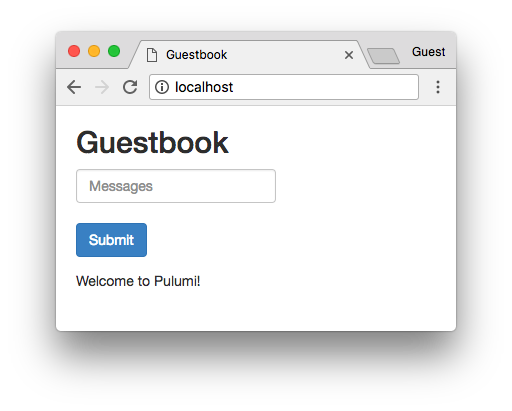Managing Kubernetes Infrastructure with .NET and Pulumi
Posted on
Last month, we announced .NET support for Pulumi, including support for AWS, Azure, GCP, and many other clouds. One of the biggest questions we heard was about Kubernetes — “can I use Pulumi to manage Kubernetes infrastructure in C#, F#, and VB.NET as I can already in TypeScript and Python today?” With last week’s release of Pulumi.Kubernetes on NuGet, you can now also deploy Kubernetes infrastructure using your favorite .NET languages.
Using .NET to build our Kubernetes infrastructure offers several benefits:
- Strong Typing: Unlike YAML, C# and F# offer a rich type system with quick feedback on potential errors.
- Rich IDE Support: Use the rich features of IDEs like Visual Studio, Visual Studio Code, and Rider to develop your Kubernetes infrastructure—completion lists, refactoring, IntelliSense, and more.
- Familiar Languages and APIs: Apply all the features of C#, F#, and VB.NET to your Kubernetes infrastructure—loops, variables, and the entire ecosystem of .NET Core libraries from
Systemto everything in NuGet. - Components and Classes: Instead of copy/pasting pages of YAML between projects, .NET code can abstract common functionality into classes and libraries for code re-use and clean infrastructure design.
Together, these benefits provide a more familiar experience for working with Kubernetes than using YAML or Helm (a mix of YAML and Go templates) for .NET developers.
Tour of Kubernetes with .NET
We can see a simple example in practice - deploying an Nginx pod into a Kubernetes cluster.
var pod = new Pod("pod", new PodArgs
{
Spec = new PodSpecArgs
{
Containers =
{
new ContainerArgs
{
Name = "nginx",
Image = "nginx",
},
},
},
});
We can deploy this with pulumi up.
$ pulumi up
Previewing update (luke-dev):
Type Name Plan
+ pulumi:pulumi:Stack basic_dotnet_kubernetes-luke-dev create
+ └─ kubernetes:core:Pod pod create
Resources:
+ 2 to create
Do you want to perform this update? yes
Updating (luke-dev):
Type Name Status
+ pulumi:pulumi:Stack basic_dotnet_kubernetes-luke-dev created
+ └─ kubernetes:core:Pod pod created
Resources:
+ 2 created
Duration: 11s
As always, Pulumi programs describe the desired state of our infrastructure, instead of an imperative process to construct that infrastructure. If we change our program, Pulumi will compute the minimal delta to apply to our Kubernetes cluster to transition to this new desired state. This almost feels like using Edit-and-Continue on our deployed Kubernetes resources—modifying our Kubernetes resources in place inside the cluster.
We can add a label to our Pod:
var pod = new Pod("pod", new PodArgs
{
+ Metadata = new ObjectMetaArgs
+ {
+ Labels = { { "app", "nginx" } },
+ },
Spec = new PodSpecArgs
{
Containers =
{
new ContainerArgs
{
Name = "nginx",
Image = "nginx",
},
},
},
});
And then see that this updates the pod in place with this new label.
$ pulumi up
Previewing update (luke-dev):
Type Name Plan Info
pulumi:pulumi:Stack basic_dotnet_kubernetes-luke-dev
~ └─ kubernetes:core:Pod pod update [diff: ~metadata]
Resources:
~ 1 to update
1 unchanged
Do you want to perform this update? details
pulumi:pulumi:Stack: (same)
[urn=urn:pulumi:luke-dev::basic_dotnet_kubernetes::pulumi:pulumi:Stack::basic_dotnet_kubernetes-luke-dev]
~ kubernetes:core/v1:Pod: (update)
[id=default/pod-wyjq31t3]
[urn=urn:pulumi:luke-dev::basic_dotnet_kubernetes::kubernetes:core/v1:Pod::pod]
[provider=urn:pulumi:luke-dev::basic_dotnet_kubernetes::pulumi:providers:kubernetes::default_1_4_0::127c0c24-8b12-4010-a544-5f5390f91e4e]
~ metadata: {
~ labels: {
+ app: "nginx"
}
}
Do you want to perform this update? yes
Updating (luke-dev):
Type Name Status Info
pulumi:pulumi:Stack basic_dotnet_kubernetes-luke-dev
~ └─ kubernetes:core:Pod pod updated [diff: ~metadata]
Resources:
~ 1 updated
1 unchanged
Duration: 3s
The real benefits of .NET come when we extract common code into a reusable component. We can do that to create a new component like a ServiceDeployment, which includes both a Kubernetes Service and Deployment using opinionated defaults. With this, we can describe entire Kubernetes applications (100s of lines of YAML), in a short and semantically meaningful snippet of C#:
var config = new Config();
var isMiniKube = config.GetBoolean("isMiniKube") ?? false;
var redisMaster = new ServiceDeployment("redis-master", new ServiceDeploymentArgs
{
Image = "k8s.gcr.io/redis:e2e",
Ports = { 6379 },
});
var redisReplica = new ServiceDeployment("redis-slave", new ServiceDeploymentArgs
{
Image = "gcr.io/google_samples/gb-redisslave:v1",
Ports = { 6379 },
});
var frontend = new ServiceDeployment("frontend", new ServiceDeploymentArgs
{
Replicas = 3,
Image = "gcr.io/google-samples/gb-frontend:v4",
Ports = { 80 },
AllocateIPAddress = true,
ServiceType = isMiniKube ? "ClusterIP" : "LoadBalancer",
});
return new Dictionary<string, object?>{
{ "frontendIp", frontend.IpAddress },
};
You can check out the implementation of this ServiceDeployment component in the Guestbook example in the Pulumi Examples repo on GitHub.

Building Docker Images for Kubernetes with .NET
In the examples so far, we have specified the Docker image to deploy as part of our Kubernetes Deployments by referring to an image already in the DockerHub or Google Container Registry. But what if we wanted to push our own custom Docker image built from our own application’s source code, and use that in our Kubernetes Pod or Deployment? This is easy to do as well with the Pulumi.Docker package. For example, we can deploy a customized Docker image derived from Nginx with the following:
var image = new Image("nginx", new ImageArgs
{
ImageName = "my-username/my-nginx",
Build = "./app",
});
var pod = new Pod("pod", new PodArgs
{
Spec = new PodSpecArgs
{
Containers =
{
new ContainerArgs
{
Name = "nginx",
Image = image.ImageName,
},
},
},
});
Instead of using the default nginx image on DockerHub, we can use our own Dockerfile from the app folder in our Pulumi project, for instance, including the following in our Dockerfile to deploy some customized files in the app/content folder to our Nginx server:
FROM nginx
COPY content /usr/share/nginx/html
When we deploy this with Pulumi, the Docker file will be build locally, pushed to DockerHub, then the image name in DockerHub referenced from the Pod in Kubernetes. All of this happens automatically, allowing you to seamlessly deploy and version both your application code and infrastructure together with a simple pulumi up.
If we wanted to push to another Docker container registry (like ACR, GCR, ECR or others), we can easily do that too using additional parameters on the Pulumi.Docker.ImageArgs class.
Cloud + Kubernetes with .NET
Because Pulumi lets you work with both Kubernetes and cloud (AWS, Azure, GCP, and more), you can also create and manage the infrastructure that builds both a managed Kubernetes cluster as well as deploying applications and services into the cluster. Using a single familiar programming model, we have access to all these various cloud technologies at our fingertips.
For example, we can deploy a managed Kubernetes cluster on DigitalOcean, and then deploy a Pod into it:
var cluster = new KubernetesCluster("do-cluster", new KubernetesClusterArgs
{
Region = "sfo2",
Version = "latest",
NodePool = new KubernetesClusterNodePoolArgs
{
Name = "default",
Size = "s-2vcpu-2gb",
NodeCount = nodeCount,
},
});
var k8sProvider = new Pulumi.Kubernetes.Provider("do-k8s", new Pulumi.Kubernetes.ProviderArgs
{
KubeConfig = cluster.KubeConfigs.Apply(array => array[0].RawConfig)
});
var app = new Pulumi.Kubernetes.Apps.V1.Deployment("do-app-dep", new DeploymentArgs
{
Spec = new DeploymentSpecArgs
{
Selector = new LabelSelectorArgs
{
MatchLabels = new InputMap<string>
{
{"app", "app-nginx"},
},
},
Replicas = appReplicaCount,
Template = new PodTemplateSpecArgs
{
Metadata = new ObjectMetaArgs
{
Labels = new InputMap<string>
{
{"app", "app-nginx"},
},
},
Spec = new PodSpecArgs
{
Containers = new ContainerArgs()
{
Name = "nginx",
Image = "nginx",
},
},
},
},
},
new CustomResourceOptions { Provider = k8sProvider });
var appService = new Pulumi.Kubernetes.Core.V1.Service("do-app-svc", new ServiceArgs {
Spec = new ServiceSpecArgs() {
Type = "LoadBalancer",
Selector = app.Spec.Apply(spec => spec.Template.Metadata.Labels),
Ports = new ServicePortArgs {
Port = 80,
}
}
}, new CustomResourceOptions {
Provider = k8sProvider
});
var ingressIp = appService.Status.Apply(status => status.LoadBalancer.Ingress[0].Ip);
if (!string.IsNullOrWhiteSpace(domainName)) {
var domain = new Domain("do-domain", new DomainArgs() {
Name = domainName,
IpAddress = ingressIp,
});
var cnameRecord = new DnsRecord("do-domain-cname", new DnsRecordArgs {
Domain = domain.Name,
Type = "CNAME",
Name = "www",
Value = "@",
});
}
Note that this example deploys resources first into DigitalOcean (a Kubernetes Cluster), then into Kubernetes itself (Deployment and Service via a Pulumi.Kubernetes.Provider configured to connect to the Kubernetes cluster in Digital Ocean), then optionally also more resources in DigitalOcean dependent on the Kubernetes Service (Domain and DnsRecord). This example is a complex infrastructure deployment, all in a few dozen lines of declarative and strongly typed C# code.
Check out the full DigitalOcean Kubernetes Cluster in C# example for more details.

Conclusion
Kubernetes support is one of several significant new additions to the Pulumi .NET support, and many more improvements are in progress over the coming weeks. Get started with Kubernetes and .NET today, and let us know what you think!

